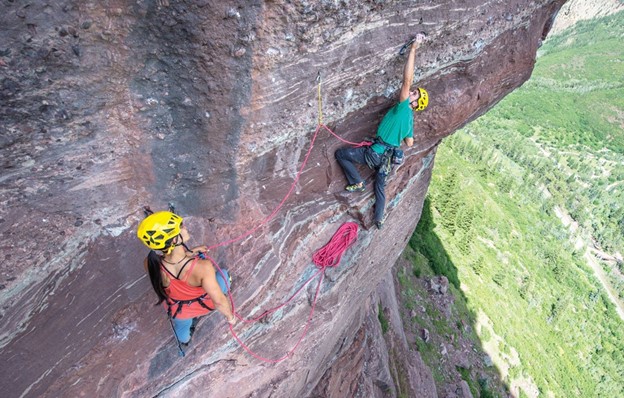
Climbers on a multipitch route, Rock and Ice
From the first time someone looked up at a towering wall of rock with thoughts of adventure, they also contemplated what it would take to return safely to the ground. Much of climbing history is told from the perspective of bold first ascents, but equally important are the developments in equipment and techniques that have allowed each successive generation to continue pushing the limit of what is possible. These advances have transformed the sport from a daredevil activity reserved only for masters of the craft, or those with good luck, to a more accessible one that is enjoyed by an increasing number of people. In this article, we will explore the history and evolution of belaying.
Belaying is the process, accomplished via a variety of methods, of protecting a climber from a lengthy fall. Just like many knots and techniques used in climbing, the origins of belaying come from the nautical world. The term belay means “to secure or fasten” and referred to sailors fastening ship lines around a cleat or other fixed point. Belaying forms the sacred bond of climbing. Climbing is classically done in parties of two and partners are literally trusting each other with their lives. The “lead climber” is the first person to climb up the rock and they are responsible for setting fall protection as they climb. Usually, the leader is the stronger and more experienced climber. The second climber, often called simply the second or the follower, would then climb up when the lead climber reached a stopping point. The leader would typically belay the second as they climbed. In the early days, belaying was primarily the responsibility of the leader and a belay of the lead climber was not common. The available techniques and ropes were not sufficient to arrest the forces produced during a leader fall. This led to the mantra, “The leader must not fall.” But, of course, sometimes the leader does fall. Thankfully, with modern gear and proper technique, most leader falls do not end in catastrophe. However, even today, the leader is generally exposed to more risk than the second during the climb.
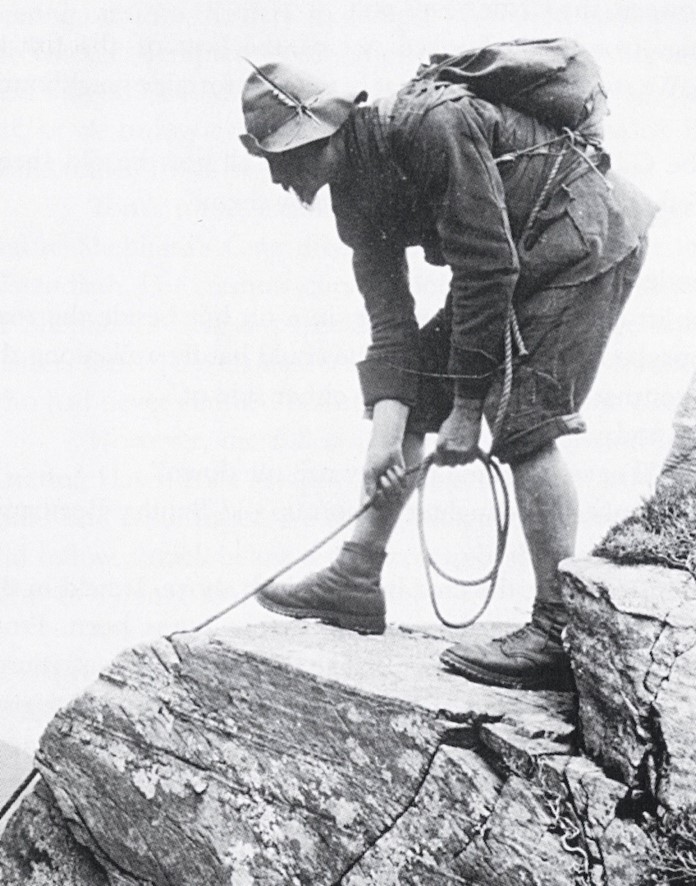
Hand-over-hand belaying, American Alpine Club
Trust me, I got you
The earliest belay technique involved the belayer pulling up rope in a hand-over-hand fashion. Using this belay style, the belayer must catch the entire force of the fall using primarily their own strength and receiving minimal assistance from friction. The belayer must maintain extreme vigilance and constant tension on the rope. Any slack in the rope will significantly increase the distance and force of the fall. This method is extremely insecure and cannot reliably hold any but the mildest falls. Belaying in this manner is dangerous for both the climber and the belayer. If a significant fall occurs, the climber will likely be dropped and the belayer may also be pulled off the cliff. This method fell out of favor once climbers discovered that they could dramatically increase safety by adding friction into the system. It has since become obsolete and is not recommended.
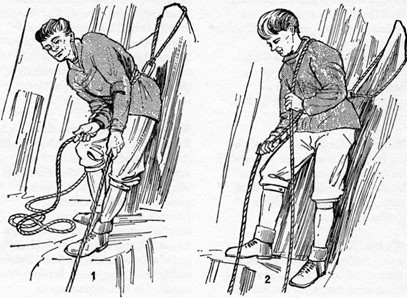
Hip belay (left) and shoulder belay (right), Weigh My Rack
The ”invention” of friction
By adding friction to their belays, climbers did not have to rely solely on brute strength. Thus, they were able to hold more forceful falls which increased safety margins. This was accomplished by wrapping the rope around an object, either a terrain feature or the belayer’s own body. While a significant improvement to the hand-over-hand method, limitations remained. The method is still not reliable for catching leader falls, which produce significantly more force than a fall while seconding. When a leader falls, they will fall twice the distance between the climber and their last protection plus any stretch in the rope. The second is essentially climbing on top rope and, assuming they have an attentive belay, will only fall a few inches plus any stretch in the rope. Attempting to catch a significant fall with a body belay could produce enough friction to burn through clothing/skin and possibly pull the belayer off the route. A catch with a terrain belay could severely abrade the ropes which were nowhere near as strong or as durable as they are today. Despite these drawbacks, both body belay and terrain belay techniques have utility today. They can be a fast and efficient method to increase safety in low angle terrain. However, these methods must be used selectively and only with proper experience as they do offer lower security than belaying with an anchor. They are not appropriate in terrain where a fall would be highly likely or when the expected force of a fall would be significant.
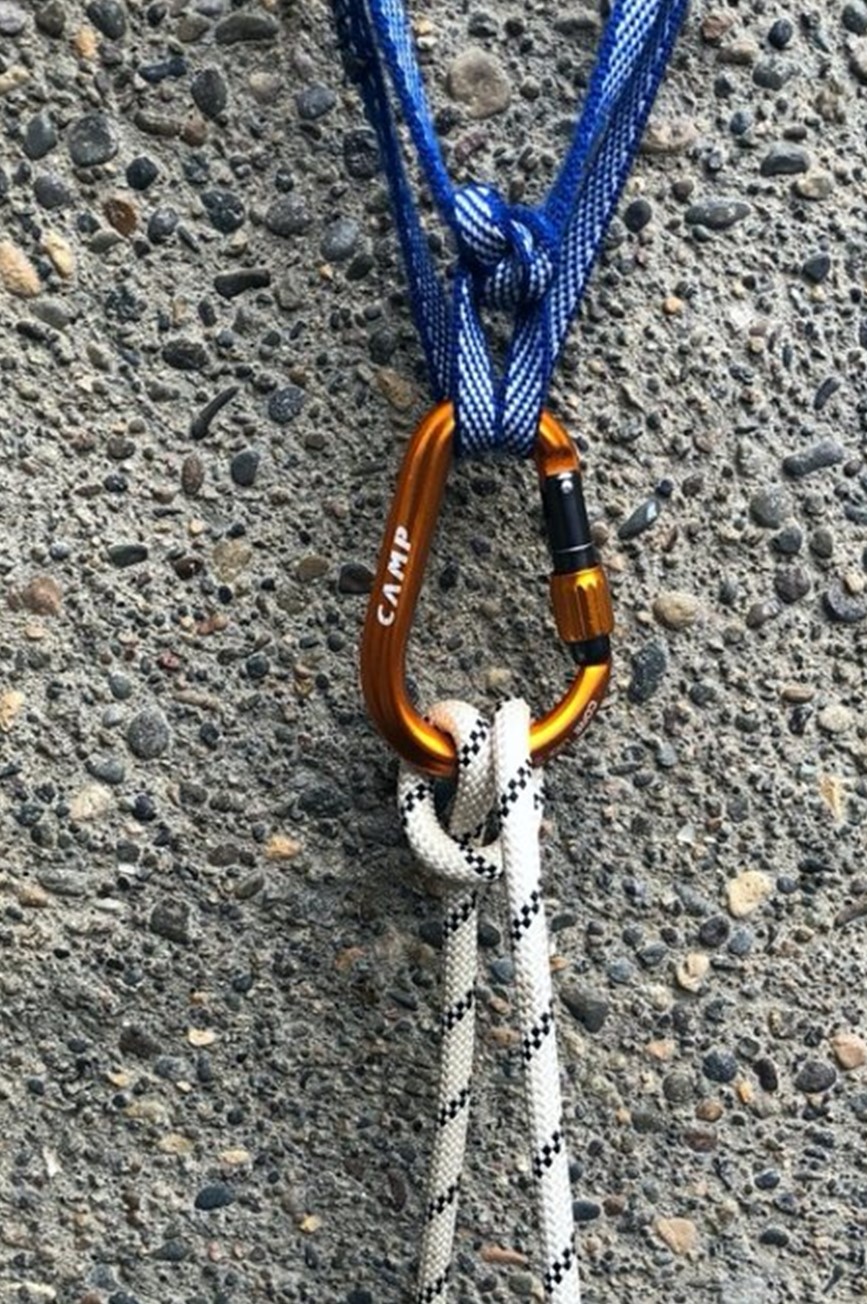
Munter hitch, Alpine Savvy
Sailors swear by it
The next belay innovation came after the popularization of the carabiner. This piece of equipment allowed multiple major improvements in climbing safety. Climbers began to experiment with various hitches that could be built on the carabiner. One of these, the Munter hitch, proved very useful for belaying. Originally known by its German name, Halmbastwurfsicherung, which translates to “half clove hitch belay.” It is usually abbreviated to HMS and now also refers to a style of carabiner designed to work well with this hitch. In the 1970’s, a Swiss mountain guide named Werner Munter popularized the technique leading to climbers calling it the Munter hitch. Using the Munter hitch, the belayer can belay from an anchor or harness. Combined with other advances in climbing equipment, a belayer could now belay a leader and expect, rather than just hope, to catch a leader fall. Leaders previously limited themselves to terrain where they felt a fall was unlikely as the consequences of falling were often fatal. With a reliable belayer and more advanced techniques/equipment, leaders could push into harder and more consequential terrain knowing that they were likely to be caught in the event of a fall. While the consequences of a leader fall could still be high, this increase in relative security was foundational to climbing as we know it today. The Munter belay remains a viable method even though more modern devices have become ubiquitous. Additionally, the Munter hitch is a must know for all climbers as it has utility beyond belaying. It can be used for lowering and rappelling. Its ability to be both locked off and released under tension make it an invaluable tool for rescue applications.

Tube-style belay devices, Camp USA, Black Diamond, and Petzl
Just a few holes in a piece of metal
While the Munter hitch represented a definite improvement over older belay techniques, it does have a drawback; it is awkward to use when belaying off a harness. The brake position for the Munter requires the brake strand to be parallel with the load strand. The load strand is the portion of rope running towards the climber or “load.” While the brake strand does not hold the full load, it must be kept under tension for the belay system to function. When using the Munter to belay from a harness, the break hand is forced up and away from the body which is an ergonomically weak position. The first device to address this problem was created in the 1970’s, known as a plate style belay device. They are made from a single piece of metal with slots to pass a bight of rope. The brake position is now with the brake strand 180° from the load strand. This improves belay ergonomics by allowing the brake hand to be pulled down and into the body which is a naturally stronger position. This style of device has continuously been improved upon over the last 50 years. First, the plate was elongated to form a tube. This effectively increased the amount of metal in contact with the rope which adds friction. Later, a groove was added to one side of the device. This creates higher friction and lower friction orientations to use for either belaying or rappelling. The latest innovation is the addition of a ring, which allows the device to be used in an autoblock configuration commonly referred to as guide mode. In this configuration, a fall pinches the brake strand and load strand together creating enough friction to lock the device. This allows the belayer more freedom as they do not have to keep a hand constantly on the brake strand. While multiple utilities for this configuration exist, it is especially common for belaying from above in multi-pitch climbing. These devices remain popular today as they are relatively light, inexpensive, and multipurpose.
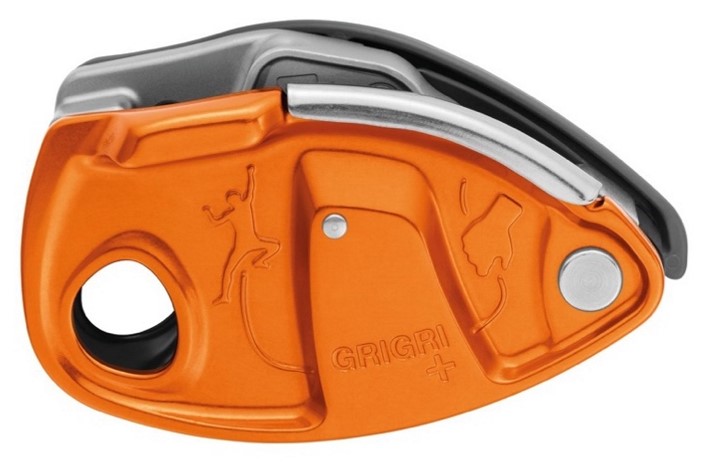
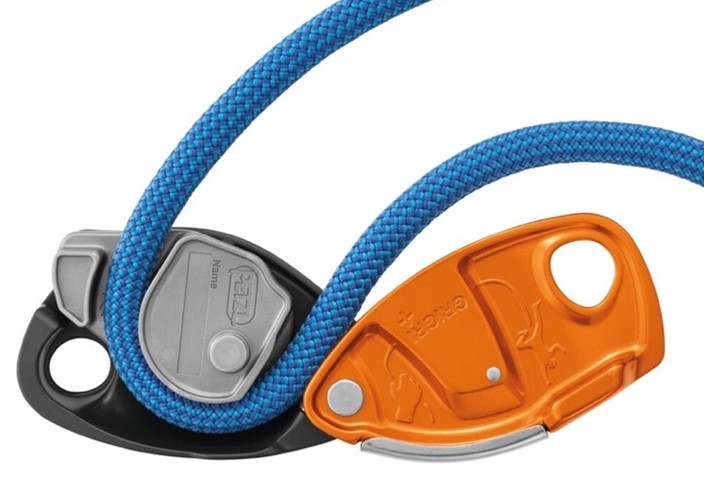
The Petzl GriGri assisted-braking device
Finally, some assistance
The most recent advance in belay equipment came in the 1990’s with the invention of assisted braking devices. They work utilizing an internal cam that engages to apply friction when sufficient force is applied to the load strand, thus locking the device. This provides an increased layer of safety as the cam will likely engage even with a less than attentive belay. Critically, the belayer still must always maintain control of the brake strand and accidents have occurred with improper use. They are now ubiquitous at indoor climbing gyms where top roping is common. They are also very popular outdoors where they can be used for both lead belaying and belaying from above. It is imperative that the device is oriented to allow free movement of the cam. If cam movement is prevented, the device will fail to lock causing the climber to fall. One important limitation is that they are only designed to work with a single rope. The use of a single rope for rock climbing is common in the US. However, the use of two ropes may be necessary for other styles of climbing, such as alpine or ice climbing, or when belaying multiple followers. With a two-rope system, either the Munter hitch or a plate style device are optimal.
Climbers today can choose from a multitude of belay devices and techniques to improve their safety while climbing. Most climbers will want to be familiar with a variety of techniques and have access to more than one style of belay device. This allows for greater flexibility and tailoring the device/technique to the situation. Belay devices, like all climbing equipment, are manufactured to high standards and rigorously tested. As a result, most climbing accidents do not come from equipment failure but from human error, poor decision making, and improper use of equipment. Each individual climber has a responsibility to seek proper training and practice for each device or technique they plan on using. It is always a good idea to discuss the belay plan and review techniques before starting a climb, especially with a new partner.